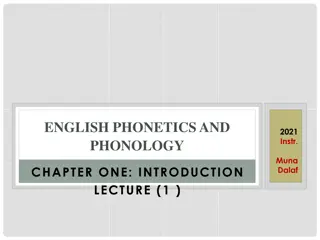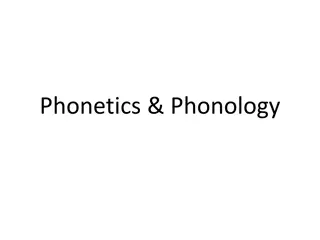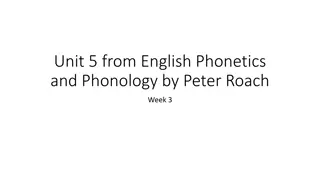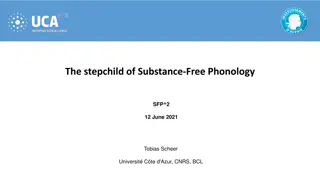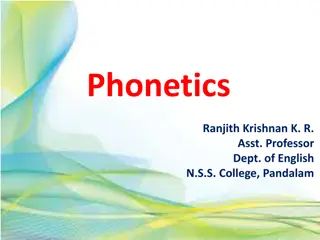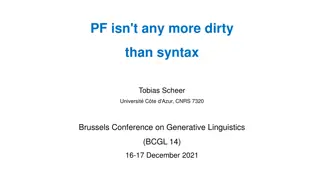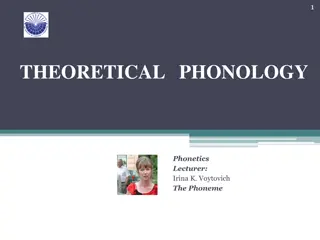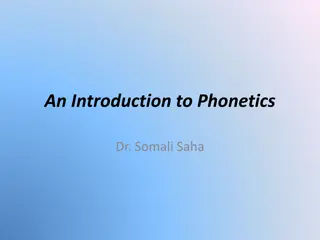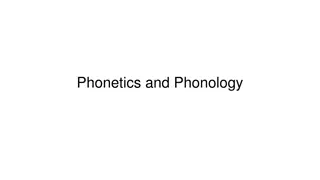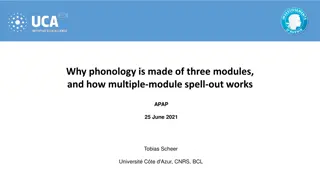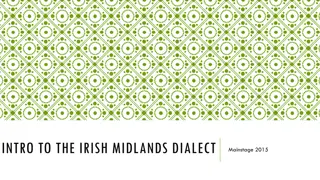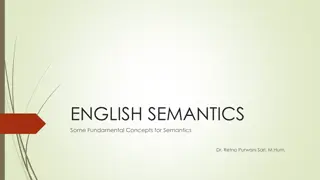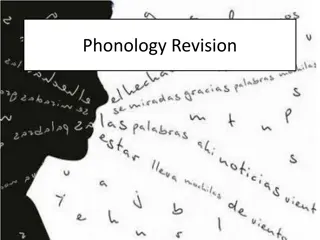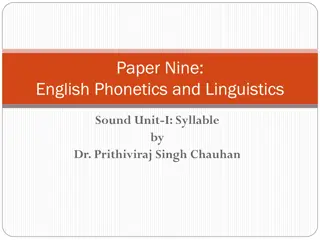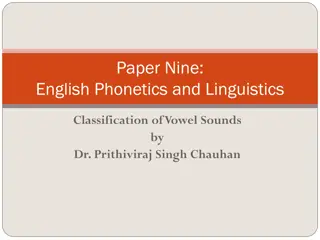Understanding Phonetics and Phonology: Key Concepts and Differences
Phonology investigates sound distribution and interaction in language, providing an inventory of sounds and their interactions. Phonotactic constraints outline permissible sound sequences within a language, while phonemes and allophones distinguish between abstract and physical sound entities. Identifying phonemes and allophones involves recognizing their distribution types: contrastive, complementary, or free variation.
Download Presentation

Please find below an Image/Link to download the presentation.
The content on the website is provided AS IS for your information and personal use only. It may not be sold, licensed, or shared on other websites without obtaining consent from the author. Download presentation by click this link. If you encounter any issues during the download, it is possible that the publisher has removed the file from their server.
E N D
Presentation Transcript
Phonology studies the distribution of sounds in a language. Studies the interaction between sounds. phonology provides an inventory of sounds, and specifies how sounds interact with each other
Phonotactic Constraints: To do a phonological analysis, we rely on its phonetics. Phonotactic constraints are restrictions specifying the possible sounds in a language. Cant be at the initial of an English word [ ], and [ ]
V a CV no VC at CVC not VCC ask CVCC ramp VCCC asked CVCCC ramps CCV flew CCCV spree CCVC flute CCCVC spleen CCVCC flutes CCCVCC strength CCVCCC crafts CCCVCCC strengths
The Foreign Accent: applying the phonotactic constraints of one language on another language. [ stud nt] = [st] [sk] [sp] [zis] = substitutes the sound [ ] with [z] sound substitution.
pin , spin , bin pin = spin aspirated [p ] = unaspirated [p] [map] = [map ] = noncontrastive a phoneme is a class of speech sounds identified by a native speaker as the same sound; a mental entity (or category) related to various allophones by phonological rules
phoneme / / , phone or allophone [ ] /p/ =[p] , [p ] [p] , [p ] = allophones = phonetically different phonemes: the abstract entities allophones: the physical entities
How to identify phonemes and allophones? we need to observe the distribution The distribution of a phone is the set of phonetic environments in which it occurs There are types of distribution which are: contrastive distribution, complementary distribution, and free variation.
[p] and [p], in Hindi they are NOT allophones of the phoneme /p/ because they can be contrasted. In Hindi, they are in contrastive distribution To test whether two sounds are contrastive or not, we use minimal pairs. Minimal pairs are pair of sounds that differ in only one sound and have different meanings
[ i:m] team vs. [i:n] teen /m/ and /n/ are contrastive in English because they can be used to contrast meaning. So, /m/ and /n/ are two separate phonemes
In English [p] and [p] are not contrastive because contrasting them does not change meaning. Then, they are said to be in complementary distribution. We say that two sounds that are in complementary distribution are allophones of one phoneme, and the occurrence of the two allophones is predictable. Then, we can predict that the allophone [p ], and not [p], will appear at the beginning of a word, as in pot; and that [p], and not [p ], will follow [s], as in spin.
Contrastive Allophonic Relation to phonemes Allophones of separate Allophones of the same phoneme phonemes Predictability of distribution Unpredictably distributed Predictably distributed How you can tell Contrastive distribution; minimal pairs Complementary distribution
To link between phonetics and phonology, we need phonological rules. A speaker s knowledge of phonological rules allows him or her to translate phonemes into actual speech sounds these phonological rules represents a part of our linguistic competence.
A phonological rule has three parts: The sound(s) affected by the rule The environment where the rule applies The result of the rule
seat [sit] -- seated [sid] loot [lut] -- looted [lu d] /t/ is pronounced as [ ] after a stressed vowel and before an unstressed vowel [t] everywhere else
X ---> Y / C_D. X: the sound affected by the rule Y: the result of the rule C_D: the environment in which the rule applies. It can be called the conditioning environment. X becomes Y when it comes after C and before D.
/t/ ---> [] / stressed vowel_unstressed vowel /t/ ---> [t] / everywhere else
Types of phonological rules 1.Aspiration:In English: Voiceless stops become aspirated when they occur at the beginning of a stressed syllable. e.g. pat [p t] 2.Deletion:In English /h/-deletion: /h/ may be deleted in unstressed syllables. e.g. He handed her his hat /hi h nd d h h z h t/ --> /hi h nd d z h t/


